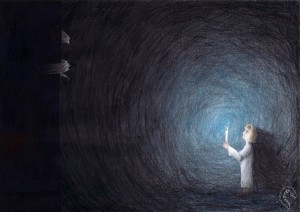
It is difficult to answer these questions in just a few words. But, saying this doesn’t help, so let me try to describe the psychological processes that are involved in this kind of suffering.
The fear of confinement and deprivation of freedom has been documented in humans and animals for a long time as related to our need for autonomy and survival (e.g. BF Skinner 1971). Having said that, some of us will have the freedom to choose the elevator, whilst others will feel forced to take the stairs. Let’s have a look at some of the psychological processes that are at work here.
We are learners. Better than any other animal on this planet. Also, we prioritise our learning. Ever left a dinner party and out of the 10 nice conversations ended up ruminating on the 1 where you said something wrong? We prioritise the negative because it helps us identify threats. As Dr Kelly Willson says, I can miss out on many meals, but I only miss out on being a meal once.
Now, let’s imagine someone played a prank on me (or, it could’ve been an accident) and locked me up in a confined place (e.g. closet) in a way that horrified me. Next time, I would be very anxious about going near a confined place. That’s learning.
Still, having a traumatic experience is not enough to produce a phobia. We go on to doing something else. I might be watching TV and in the show, see someone enter a confined place. I might become very distressed about it and may be even act it out. And what would my loving caring parents do with the show? Probably turn it off or change the channel and comfort me. And what would I feel? That’s right – relief. For me, relief is rewarding, while distress is punishing and we have ourselves a system by which I’m regularly punished for confined spaces in my world and rewarded when they are gone. This may occur throughout my life in myriad of micro-situations across many different areas in my life. We could teach a pigeon to press buttons through such powerful system of rewards and punishments.
We are not pigeons, however, and this alone is not enough to produce a phobia. We go a step further. We have amazingly intelligent minds. Intelligent enough to learn to experience our internal events as positive or negative, rewards or threats. For example, I may feel anxious about the anxiety that shows up if I enter an elevator. The more anxious I am about my anxiety the more anxiety there is to be anxious about. It’s anxiety-provoking to even read this sentence! No other animal can do this, only humans. We can also be incredibly resourceful in predicting and avoiding anxiety-provoking situations, which provides the learning to slowly shrink our world and grow the phobia.
Trouble is that the psychological process we are dealing with (struggle switch: aversion vs willingness) has to do with self-preservation and is crude and lightning fast. This is helpful when dealing with emergencies, but difficult to change when unworkable. For example, if someone kicked a ball toward my head, I will have appraised this as a threat and executed a complex multi-muscle deflecting/ducking motion ever before recognising what happened or feeling anything about it. Notice here – threat-appraisal and response before thought and before emotion. This means that I will find it difficult to ‘think myself’ into appraising a threat in any other way. If I learnt that anxiety is a threat, I will very quickly respond to it with ‘aversion’ (struggle switch position) and experience anxiety about anxiety.
Notice much of what I wrote here deals with learning, which should be good news for those suffering with claustrophobia. Bad news is that the process takes time and focused effort to develop ‘willingness’ (struggle switch position) to experience anxiety. More good news is that being a good learner means we are well equipped to undergo such changes. I will readily agree with you that it is easier said than done. If your experience reached a threshold of phobia, I would also recommend engaging with a therapist.
Still, much can be done without treatment. Here are the 4 steps:
1. Gradual – you will gradually expand your skills. There is not going to be an instant shift. You will also not find perfection at any of the skills you are learning. I would be concerned to hear someone say that they are the perfect version of themselves. This also means that you will gradually increase the level of challenge you are confronting.
2. Open up – when facing a dark cave, I am likely to imagine there is a ‘monster’ there and feel anxiety. The function is ‘don’t go in, stay safe’. Notice, I protect from external threats with scary thoughts (monster) and emotional/physical distress (anxiety). Trouble starts when I experience the same with my internal threatening events – combating my thoughts with thoughts and anxiety with anxiety. Practising experiencing internal events willingly helps get unstuck. This is the difference between loving the roller-coaster or hating it. You can choose what you are willing to experience and how long for and gradually increase the challenge. Being a human and therefore an amazing learner will help. Being kind and gentle with yourself during this learning is essential.
3. Centre – or being grounded or anchored refers to the ability to maintain clear connection to internal and external worlds. Notice, this is opposite to being caught up in fighting with myself. This one is tricky to deliver in a couple of sentences, but there is plenty of literature about developing this.
4. Engage – learn to have a clear verbal statement of what matters to you and actively put one foot in front of the other in the said direction. What kind of a person do you want to be? What kind of parent? What kind of friend? What’s the next most important step?
I hope this helps! For more resources on how to develop these skills, see here our Resources page.

